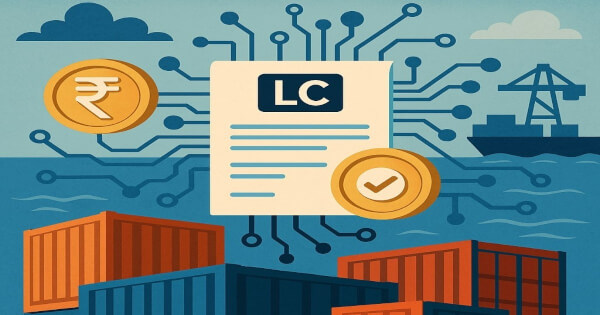Khushi V Rangdhol
Jun 30, 2025 07:23
India faces a $300 billion export-credit hole, however blockchain’s “tokenised trade finance” might streamline processes, digitizing LCs and invoices to boost entry for small corporations.

India’s exporters ship about US $770 billion in items and providers a 12 months, but small and mid-size corporations nonetheless wrestle to show buy orders into financial institution credit score. The Asian Improvement Financial institution’s newest Commerce Finance Gaps, Progress and Jobs survey pegs the worldwide shortfall at US $2.5 trillion in 2022, up virtually 50 % from the pandemic low. Business teams and IFC research put India’s share of that hole at roughly US $300 billion, concentrated in working-capital loans that by no means attain MSMEs. Blockchain builders say the treatment could also be “tokenised trade finance”—digitising invoices, letters of credit score and collateral into on-chain belongings that buyers wherever can fund in actual time.
Why Letters of Credit score Nonetheless Run on Paper
A typical textile exporter in Tiruppur ships cloth to a purchaser in Milan beneath a letter of credit score (LC). The LC passes by way of 4 banks, six paper paperwork and a guide checking loop that usually lasts 7–10 days. Any mismatch—an additional comma on a invoice of lading—can freeze fee. Banks subsequently ration credit score to recognized corporates and over-collateralise the remainder, leaving smaller suppliers in limbo.
How Tokenisation Adjustments The Workflow
- Doc digitisation. Payments of lading, inspection reviews and warehouse receipts are hashed and timestamped on a permissioned ledger.
- Good-contract LC. Phrases encoded within the contract self-execute: when the transport line uploads IoT-verified arrival knowledge, fee triggers mechanically.
- Bill tokens. The receivable turns into a fungible token that may be discounted or repo-financed by international liquidity swimming pools 24/7.
A blockchain report can not eradicate fraud, nevertheless it slashes the fee and time of doc matching—banks can lengthen credit score in opposition to real-time knowledge relatively than days-old PDFs.
Three Reside Rails to Watch
- Contour 2.0 – The once-faltering LC consortium discovered new life after Singapore-based Xalts acquired the platform in 2024. Indian banks together with ICICI and Citi India have since run pilot on-chain LCs that reduce processing time from 5–7 days to beneath 24 hours.
- SGTraDex – Singapore’s trade-data change went dwell in mid-2024 and now pipes digitised paperwork to DBS trade-finance desks; Indian exporters utilizing Singapore forwarders can choose in through a single API.
- Undertaking mBridge – A joint CBDC platform of the BIS Innovation Hub, Hong Kong, China, Thailand and the UAE. Its MVP, reached in 2024, settled pilot cross-border trades in seconds and flagged programmable commerce finance as a top-priority use case. RBI is an observer; participation would let rupee-settled LCs clear alongside dirham or yuan on the identical ledger.
India’s Personal Experiments
- GIFT Metropolis sandbox. The Worldwide Monetary Providers Centres Authority (IFSCA) is reviewing tokenised-assets guidelines that may let fintechs problem rupee or greenback LC tokens contained in the SEZ. A public session closed in February 2025; remaining pointers are promised this 12 months.
- EXIM Financial institution digital LC pilot. Price range paperwork for FY 2025 point out a proof-of-concept to “tokenise export credit guarantees,” though no public outcomes are out but. If adopted, the scheme would let banks rediscount EXIM-guaranteed tokens with international buyers, releasing balance-sheet house for recent MSME loans.
What Might Go Proper
- Value curves. Contour trials reduce financial institution processing charges by 50–70 %. At scale, these financial savings may be priced into decrease LC advisory expenses for small exporters.
- Threat sharing. Tokenised invoices can settle in swimming pools funded by insurers, hedge funds or growth banks. A brand new US $1 billion HSBC–IFC facility introduced in late 2024 explicitly targets digital trade-finance belongings in rising markets.
- Information visibility. A shared ledger offers regulators immediate AML/KYC sightlines—no extra searching by way of couriered paperwork when crimson flags emerge.
What Might Stall Progress
- Authorized enforceability. India’s Negotiable Devices Act nonetheless assumes a paper invoice of change. Parliament should amend “possession” definitions earlier than a purely digital LC is totally court-proof.
- GST and stamp responsibility. Token transfers can set off a number of state-levy interpretations; readability is required to cease mid-chain friction.
- On-chain liquidity. Right now’s tokenised-LC pilots clear within the tens of hundreds of thousands, not billions. With out bigger secondary swimming pools, banks will maintain one foot within the previous system.
A Playbook from Hong Kong and Singapore
Each hubs deal with tokenised commerce belongings as uncertificated securities, clearing them by way of licensed “market operators.” That certainty let the Hong Kong Financial Authority settle its 2023 tokenised inexperienced bond in T + 1, 5 occasions sooner than a vanilla international observe. If Mumbai and Delhi emulate that authorized plumbing, token swimming pools in Hong Kong or Dubai might seamlessly fund Gujarat-issued LC tokens—matching India’s exporters with international greenback liquidity at velocity.
Outlook
Tokenisation is not going to magic away India’s US $300 billion export-credit hole in a single day, however early pilots present it could possibly shave days off settlement, unlock new investor bases and shrink compliance prices—the trio of frictions that lock MSMEs out of commerce finance. The following 12 months can be decisive: if GIFT Metropolis rolls out its rulebook and RBI joins mBridge trials, the primary totally regulated, on-chain LC corridors might be dwell by 2026. That may flip blockchain from convention jargon right into a working capital machine—precisely the place Indian exporters need assistance most.
Picture supply: Shutterstock
#Tokenised #Commerce #Finance #Blockchain #Lastly #Bridge #Indias #Billion #ExportCredit #Hole
Leave a Reply